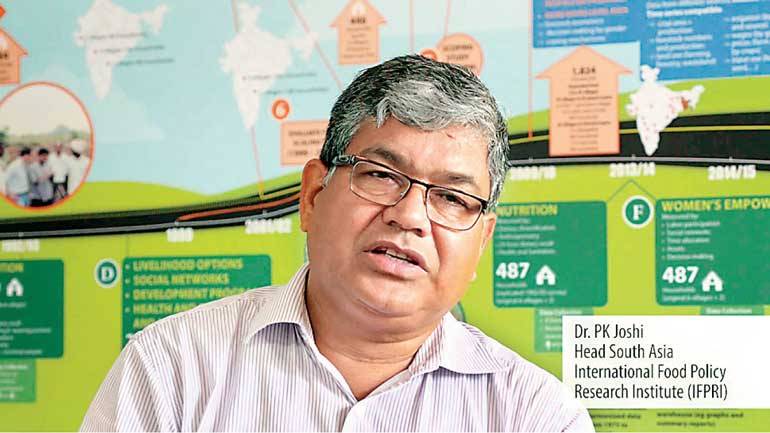Tuesday Nov 26, 2024
Tuesday Nov 26, 2024
Monday, 20 July 2015 00:00 - - {{hitsCtrl.values.hits}}

By Waruni Paranagamage
International Food Policy Research Institute (IFPRI)South Asia Director Dr. P.K. Joshi asserted that South Asian (SA) countries have lot to learn from Southeast Asian food security provision, including policy inputs, in order to eliminate the poverty and undernourishment in the region.
Speaking at the inauguration of the two-day national consultation workshop on ‘Key Challenges and Opportunities for food Security Policies in Sri Lanka’, organised by the Institute of Policy Studies of Sri Lanka (IPS) together with IFPRI at Colombo, Dr. P.K. Joshi pointed out that even though South Asia had achieved the Millennium Development Goals (MDG), it had an alarming level of extreme hunger according to the Global Hunger Index (GHI) 2014.
“Undernourishment, child mortality and underweight indicators are showing that SA countries including Sri Lanka are below than other countries. 65% of the world’s poor live in Asia while 33% live in South Asia. 16% of those in extreme poverty live in India and Bangladesh,” he explained.
Food security is achieved when all people, at all times, have physical and economic access to sufficient, safe and nutritious food to meet their dietary needs and food preference for an active and healthy life (FAO). The definition provides the basis for the four components of food security widely adopted today: availability, accessibility, utilisation and stability.
“Sri Lanka and India have been ranked 37 and 69 respectively in GHI out of 79 countries. But the performance of Sri Lanka and Southeast Asia is much better. We need to learn lessons from the Southeast Asian countries and also need to learn lessons from Sri Lanka,” Dr Joshi added.
He said that even though the SA had high economic growth, the poor share of agriculture to GDP had created poverty and undernourishment in the region.
“In South Asia, the other sectors in the economy are growing faster than the agricultural sector. The share of agriculture to GDP is declining, but agricultural dependency is very high. Hence income in the agricultural sector is also not increasing,” Dr. Joshi outlined.
Regarding Sri Lanka’s situation, about 5.2 million people – equivalent to a quarter of the population– were estimated as undernourished(in terms of dietary energy supply) in 2014. According to FAO, 21.6% of children below age five do not have the recommended weight for age and 19.2% and 11.8% are suffering from stunting and wasting in 2009.
“Though poverty is not a big issue in Sri Lanka, undernourishment is the biggest problem. South Asian indicators of undernourishment, child undernourishment and underweight are not in a good state,” he added.
He further pointed out that the small agricultural holdings in SA countries were not enough to fulfil the food demand in the region.“Most South Asians are marginal farmers with less than one acre of land. Farmers are depending on tiny lands, so the sustainability of the sector is in question.”
He emphasised that investment in agricultural research was immediately needed to address food and nutrition security in South Asia.“We need more invest in agricultural research. China,for example, is investing heavily in agriculture research,” he added.
Dr. Joshi further emphasised that food processing in SA was also not in a good condition and the majority of the farmers were not concerned about food safety although they were aware of food quality.
“In South Asia, 30% rice production was lost while handling and 70% of farmers who are growing paddy are marginal farmers. The food security methods they use are not enough to combat climate changes,” he added.
Dr. Joshi mentioned some key areas recommended by the World Food Program Report, Ministry of Agriculture, UNDP for Sri Lanka to address the problem of food and nutrition security.
He said social protection programs, unconditional cash or vouchers for vulnerable groups for food and generating employment opportunities could address poverty and undernourishment problems in Sri Lanka.